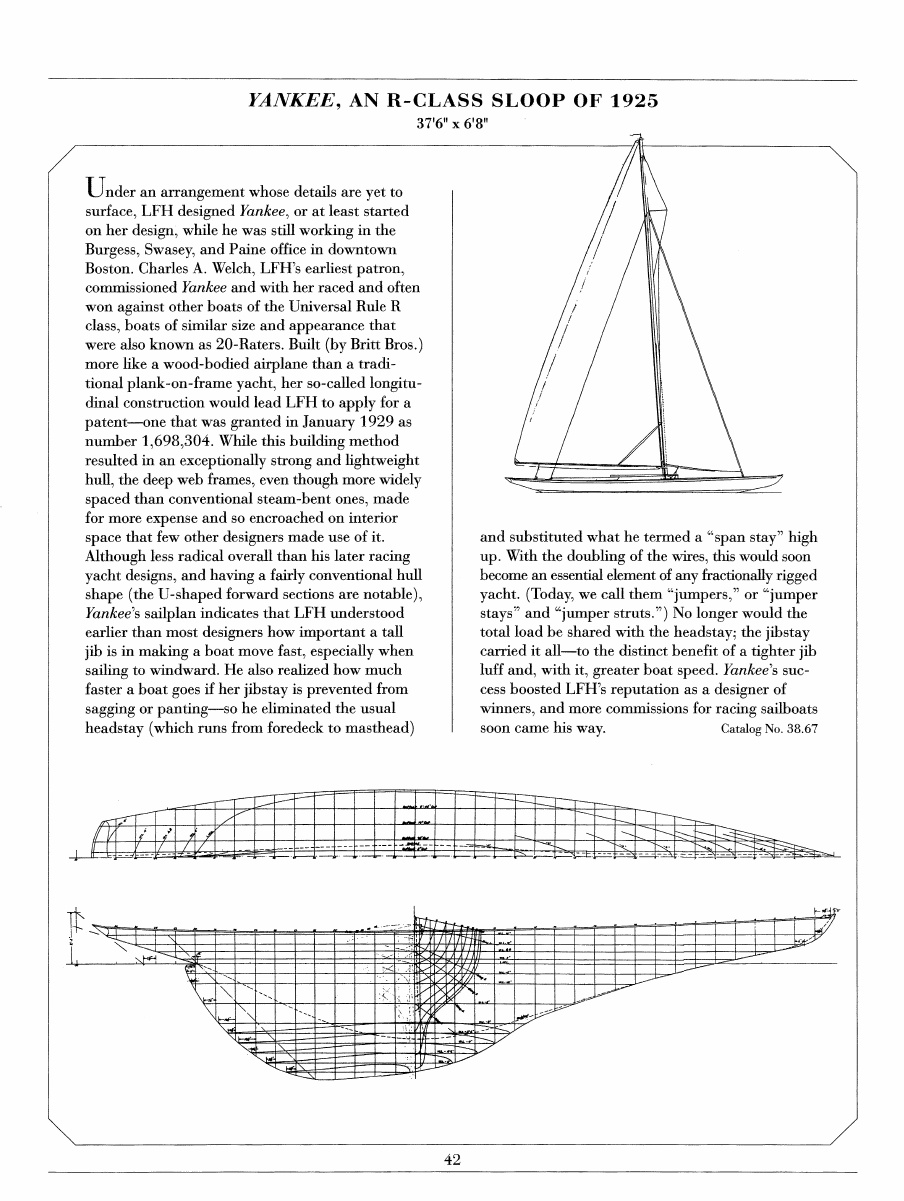YANKEE R16

General Information
Name:
YANKEE
Sail Number:
R16
Class:
R-Class
Current Condition:
Missing/Unknown
Design & Construction
Designer:
L. Francis Herreshoff
Year Designed:
1925
Builder:
Britt Bros
Year Built:
1925
Measurements
LOA:
37'6"
Beam:
6'8"
Description
YANKEE, AN R-CLASS SLOOP OF 1925 37'6" x 6'8"
Under an arrangement whose details are yet to surface, LFH designed Yankee, or at least started on her design, while he was still working in the Burgess, Swaney, and Paine office in downtown Boston. Charles A. Welch, LFH's earliest patron, commissioned Yankee and with her raced and often won against other boats of the Universal Rule R class, boats of similar size and appearance that were also known as 20-Raters. Built (by Britt Bros.) more like a wood-bodied airplane than a traditional plank-on-frame yacht, her so-called longitudinal construction would lead LFH to apply for a patent--one that was granted in January 1929 as number 1,698,304. While this building method resulted in an exceptionally strong and lightweight hull, the deep web frames, even though more widely spaced than conventional steam-bent ones, made for more expense and so encroached on interior space that few other designers made use of it. Although less radical overall than his later racing yacht designs, and having a fairly conventional hull shape (the U-shaped forward sections are notable), Yankee's sailplan indicates that LFH understood earlier than most designers how important a tall jib is in making a boat move fast, especially when sailing to windward. He also realized how much faster a boat goes if her jibstay is prevented from sagging or panting—so he eliminated the usual headstay (which runs from foredeck to masthead)
and substituted what he termed a "span stay" high up. With the doubling of the wires, this would soon become an essential element of any fractionally rigged yacht. (Today, we call them "jumpers," or "jumper stays" and "jumper struts.") No longer would the total load be shared with the headstay; the jibstay carried it all—to the distinct benefit of a tighter jib Tuff and, with it, greater boat speed. Yankee's suc-cess boosted LFH's reputation as a designer of winners, and more commissions for racing sailboats soon came his way.
Under an arrangement whose details are yet to surface, LFH designed Yankee, or at least started on her design, while he was still working in the Burgess, Swaney, and Paine office in downtown Boston. Charles A. Welch, LFH's earliest patron, commissioned Yankee and with her raced and often won against other boats of the Universal Rule R class, boats of similar size and appearance that were also known as 20-Raters. Built (by Britt Bros.) more like a wood-bodied airplane than a traditional plank-on-frame yacht, her so-called longitudinal construction would lead LFH to apply for a patent--one that was granted in January 1929 as number 1,698,304. While this building method resulted in an exceptionally strong and lightweight hull, the deep web frames, even though more widely spaced than conventional steam-bent ones, made for more expense and so encroached on interior space that few other designers made use of it. Although less radical overall than his later racing yacht designs, and having a fairly conventional hull shape (the U-shaped forward sections are notable), Yankee's sailplan indicates that LFH understood earlier than most designers how important a tall jib is in making a boat move fast, especially when sailing to windward. He also realized how much faster a boat goes if her jibstay is prevented from sagging or panting—so he eliminated the usual headstay (which runs from foredeck to masthead)
and substituted what he termed a "span stay" high up. With the doubling of the wires, this would soon become an essential element of any fractionally rigged yacht. (Today, we call them "jumpers," or "jumper stays" and "jumper struts.") No longer would the total load be shared with the headstay; the jibstay carried it all—to the distinct benefit of a tighter jib Tuff and, with it, greater boat speed. Yankee's suc-cess boosted LFH's reputation as a designer of winners, and more commissions for racing sailboats soon came his way.